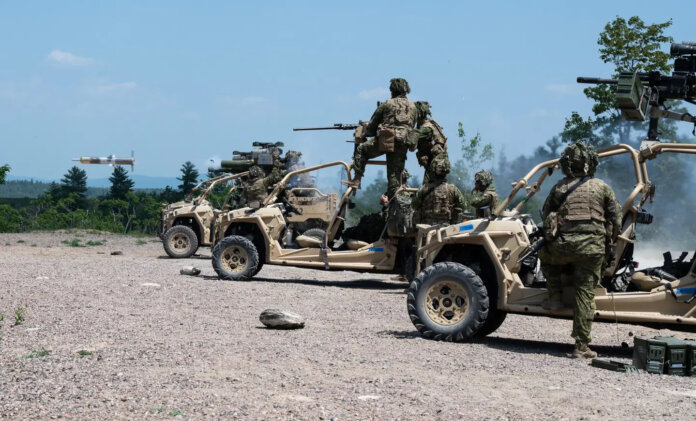The 3d Battalion of the Royal Canadian Regiment (RCR) during its recent LETHAL WEAPON Field Exercise conducted operational and firing trials of its Polaris MRZR 4×4 all-terrain vehicles mounted with a number of heavy crew-served weapon systems.
Weapons integrated included installation of the TOW anti-tank guided missile, the M2 .50 Caliber Heavy Machine Gun, and the H&K C16 40mm Automatic Grenade Launcher. Aspects of the weapon configurations considered included technical compatibility with the MRZR platform and confirmation of its mobility, stability, transportability, and firing suitability. The RCR further explored the tactical employment of the armed light vehicles during the exercise.
Polaris All-Terrain Vehicles have been in use by three Canadian Forces infantry battalions since 2017 when it acquired and fielded the MRZR-D through a competed buy-and-try. Each of the three battalions received twelve MRZRs and four specifically designed tactical trailers for evaluation. This Light Force Enhancement project is aimed toward enhancing mobility, tactical communications, and dismounted weapon systems such as medium range anti-armour, indirect fire, and lightweight protection.
The light utility vehicle, which would be transportable by CH-47F Chinook helicopter and CC-130J aircraft, initially considered reconnaissance, advanced force elements, for combat service support and casualty evacuation. The use of the MRZR equipped with heavy infantry weapons in Exercise LETHAL WEAPON is the first demonstration of this tactical concept by the Canadian Forces. Versions of the Polaris MRZR have also been fielded by the British Royal Marines and by the US Marine’s ULTV (Ultra Light Tactical Vehicle).
In 2020 the Directorate of Land Requirements project team announced a requirement for the “Tactical Mobility Platform” (TMP). This vehicle would support light infantry in reaching off-road objectives far quicker and easier than by foot.
Major Tony Ross, project director for Light Force Enhancement (LFE), at the time of the announcement explained “the platform would include combat and cargo variants, along with trailers. It should be capable of transporting enough equipment, including weapons, ammunition and water, to sustain soldiers for 48 to 72 hours. Each TMP will be operated by one driver, with space on the top for a gunner who will be able to operate the section’s heavy weapon systems, up to a TOW missile or automatic grenade launcher system.” Final quantities have yet to be determined, but the plan includes enough for the Army’s three light infantry battalions, as well as the three light engineer squadrons and three light artillery tactical groups. Initial estimates suggest “a requirement of between 300 and 330 ultra-light tactical mobility platforms,” said Ross, “210 to 230 of the tactical variants and 90 to 100 of the cargo variants.”
The TMP will be acquired through a competitive bid process with an RFi having been released.
In consideration of the TMP objectives the RCR practical evaluation of the technical feasibility and tactical employment of its armed light ATV 4x4s appears to have proved valuable. Major Samir Khelil, a DLR project officer at the trials, observed “these verified the need in TMP for a suspension suited for the .50 recoil and a greater payload for three-days operations”. The Directorate of Land Requirements is pursuing further discussions with interested vendors.
by Stephen W. Miller
















